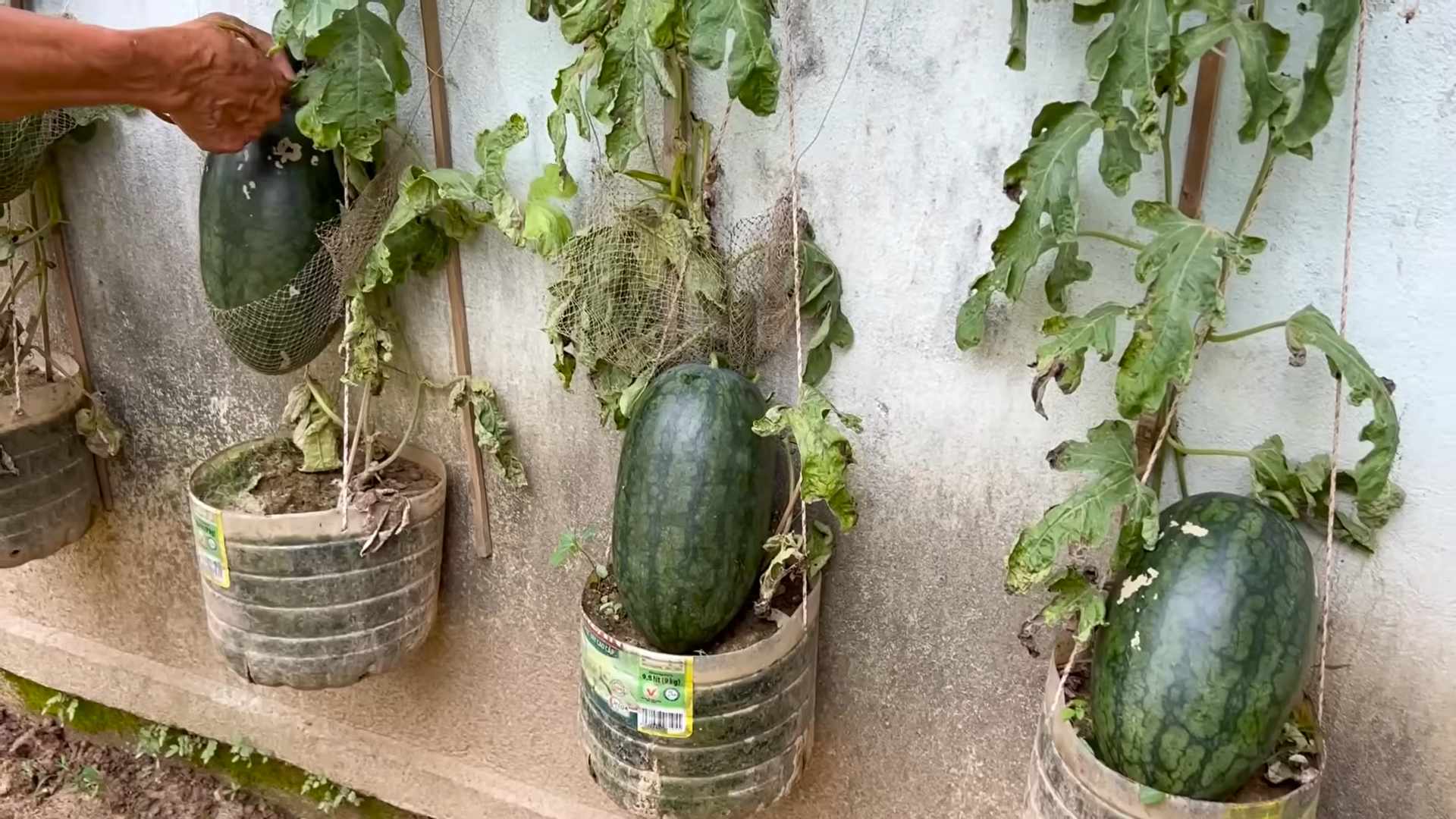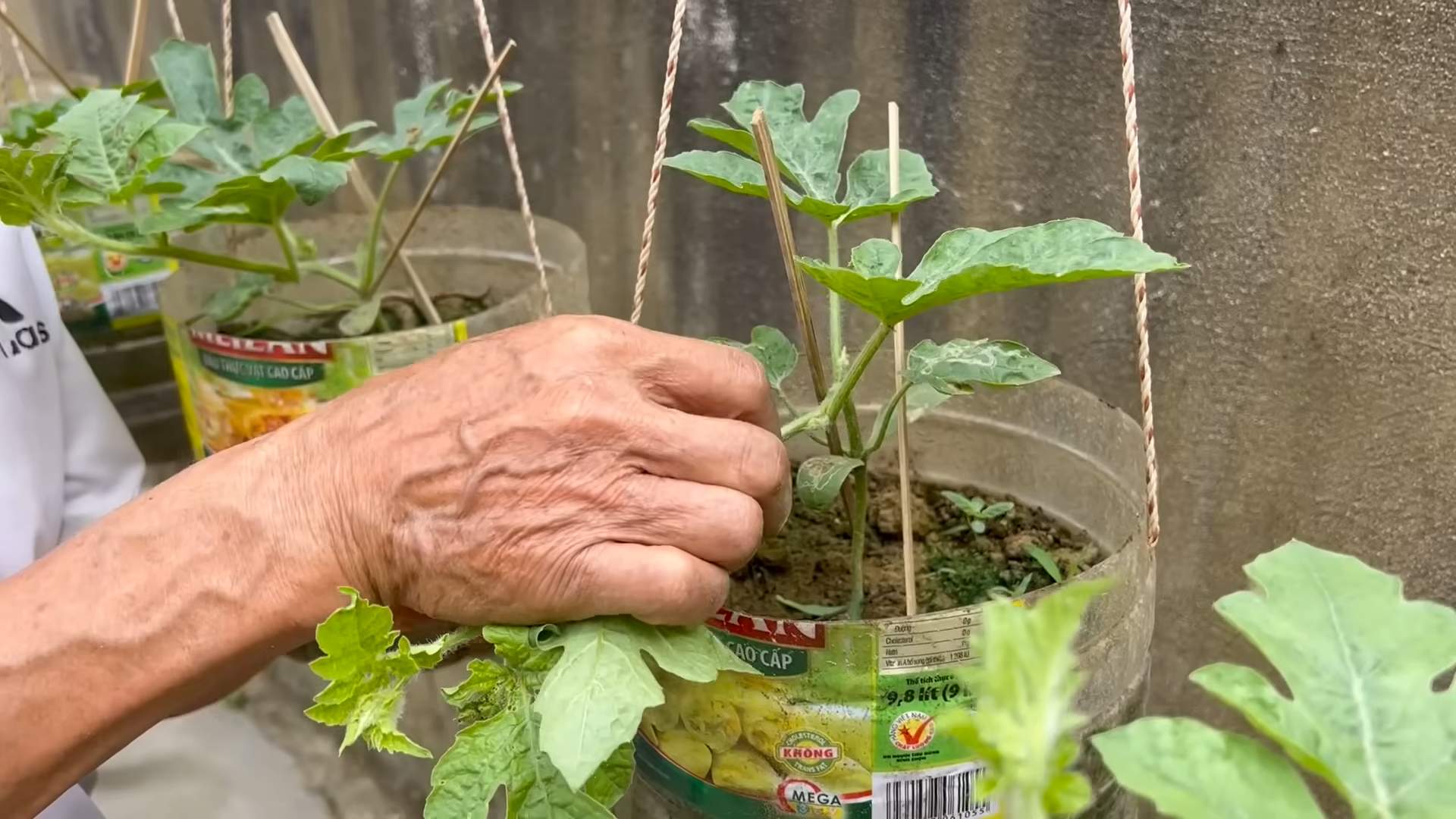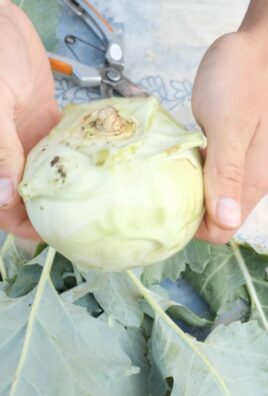Grow Watermelons at Home – imagine sinking your teeth into a juicy, sun-ripened watermelon that you nurtured from seed to fruit, right in your own backyard! Forget those bland, store-bought melons; this year, we’re taking control of our watermelon destiny with some simple, yet effective, DIY tricks.
Watermelons have a rich history, dating back thousands of years to Africa, where they were prized for their hydrating properties in arid climates. Over time, they spread across the globe, becoming a symbol of summer and refreshment in countless cultures. But you don’t need a sprawling farm to enjoy this delicious fruit.
Many people shy away from growing watermelons, thinking they require vast amounts of space and expert gardening skills. But that’s simply not true! With a few clever hacks and a little bit of know-how, even beginner gardeners can successfully grow watermelons at home, regardless of their garden size. This article will equip you with the knowledge to overcome common challenges, maximize your yield, and enjoy the sweet taste of homegrown success. We’ll explore everything from choosing the right variety for your climate to creating the perfect growing conditions, ensuring you’ll be harvesting your own watermelons before you know it. Let’s get started!

Grow Your Own Juicy Watermelons: A Beginner’s Guide
Hey there, fellow gardening enthusiasts! Ever dreamt of biting into a sweet, homegrown watermelon on a hot summer day? Well, dream no more! Growing your own watermelons might seem intimidating, but trust me, it’s totally achievable, even for beginners. I’m going to walk you through everything you need to know, from choosing the right variety to harvesting your prize-winning melon. Let’s get started!
Choosing the Right Watermelon Variety
First things first, you need to pick a watermelon variety that suits your climate and garden space. Here’s a quick rundown of some popular choices:
* ‘Sugar Baby’: This is a classic, compact variety that’s perfect for smaller gardens. It matures quickly (around 75 days) and produces small, sweet melons.
* ‘Crimson Sweet’: A widely popular variety known for its disease resistance and large, juicy melons. It takes about 85 days to mature.
* ‘Jubilee’: This heirloom variety produces large, oblong melons with a thick rind, making it great for shipping (or just sharing with friends!). It needs around 95 days to mature.
* ‘Yellow Doll’: If you’re looking for something different, try this yellow-fleshed watermelon. It’s super sweet and matures in about 70 days.
* ‘Bush Sugar Baby’: If you are really limited on space, this bush variety is perfect. It produces smaller melons on a compact vine.
Consider your growing season length and available space when making your decision. I personally love ‘Sugar Baby’ for its early maturity and manageable size.
Preparing Your Garden Bed
Watermelons are heavy feeders, meaning they need a lot of nutrients to thrive. So, preparing your garden bed properly is crucial.
* Sunlight: Watermelons need at least 6-8 hours of direct sunlight per day. Choose a sunny spot in your garden.
* Soil: Watermelons prefer well-drained, sandy loam soil with a pH between 6.0 and 6.8.
* Soil Testing: I highly recommend getting your soil tested to determine its nutrient content and pH. You can usually get this done at your local agricultural extension office.
* Amending the Soil: Based on your soil test results, amend your soil with plenty of organic matter, such as compost, well-rotted manure, or peat moss. This will improve drainage, fertility, and water retention.
* Fertilizing: Incorporate a balanced fertilizer (e.g., 10-10-10) into the soil before planting. Follow the instructions on the fertilizer package for application rates.
Starting Watermelon Seeds
You can either direct sow watermelon seeds in your garden or start them indoors. Starting indoors gives you a head start, especially in cooler climates.
* When to Start: Start seeds indoors about 3-4 weeks before the last expected frost.
* Materials: You’ll need seed starting trays or pots, seed starting mix, and a heat mat (optional).
* Planting: Sow seeds about 1 inch deep in the seed starting mix.
* Watering: Keep the soil consistently moist but not waterlogged.
* Warmth: Watermelon seeds germinate best at temperatures between 70-85°F (21-29°C). Use a heat mat to maintain optimal soil temperature.
* Light: Once the seedlings emerge, provide them with plenty of light. A sunny windowsill or grow lights will work.
* Hardening Off: Before transplanting your seedlings outdoors, you need to harden them off. This means gradually exposing them to outdoor conditions over a period of 7-10 days. Start by placing them in a sheltered spot for a few hours each day, gradually increasing the amount of time they spend outdoors.
Transplanting Watermelon Seedlings
Once the danger of frost has passed and the soil has warmed up to at least 60°F (15°C), it’s time to transplant your watermelon seedlings into the garden.
1. Prepare the Planting Holes: Dig holes that are slightly larger than the root balls of your seedlings. Space the holes about 2-3 feet apart for smaller varieties like ‘Sugar Baby’ and 4-6 feet apart for larger varieties like ‘Crimson Sweet’ or ‘Jubilee’.
2. Add Compost: Add a handful of compost to each planting hole.
3. Carefully Remove Seedlings: Gently remove the seedlings from their containers, being careful not to damage the roots.
4. Plant Seedlings: Place the seedlings in the planting holes and backfill with soil. Make sure the top of the root ball is level with the soil surface.
5. Water Thoroughly: Water the seedlings thoroughly after planting.
6. Mulch: Apply a layer of mulch around the plants to help retain moisture, suppress weeds, and regulate soil temperature. Straw, wood chips, or black plastic mulch are all good options.
Caring for Your Watermelon Plants
Now that your watermelon plants are in the ground, it’s time to provide them with the care they need to thrive.
* Watering: Watermelons need consistent moisture, especially during fruit development. Water deeply and regularly, aiming for about 1-2 inches of water per week. Avoid overhead watering, as this can promote fungal diseases. Drip irrigation or soaker hoses are ideal.
* Fertilizing: Side-dress your watermelon plants with a balanced fertilizer every 2-3 weeks. You can also use a liquid fertilizer, such as fish emulsion or seaweed extract.
* Weeding: Keep the garden bed free of weeds, as they can compete with your watermelon plants for nutrients and water.
* Pruning: While not essential, pruning can help improve air circulation and fruit production. Remove any suckers (small shoots that grow from the base of the plant) and any yellowing or diseased leaves.
* Pollination: Watermelons require pollination to set fruit. Bees are the primary pollinators, so encourage them to visit your garden by planting flowers that attract bees. If you’re not seeing a lot of bee activity, you can hand-pollinate the flowers. To do this, use a small paintbrush to transfer pollen from the male flowers (which have a long, thin stem) to the female flowers (which have a small, immature watermelon at the base).
* Vine Training: As your watermelon vines grow, you can train them to grow in a specific direction. This can help save space and prevent the vines from sprawling all over your garden. You can use stakes or trellises to support the vines.
* Protecting from Pests and Diseases: Watermelons can be susceptible to various pests and diseases, such as aphids, squash bugs, vine borers, and powdery mildew. Inspect your plants regularly for signs of pests or diseases and take action promptly. Use organic pest control methods whenever possible.
Harvesting Your Watermelons
The most exciting part! Knowing when to harvest your watermelons can be tricky, but here are a few telltale signs:
1. The Tendril Test: The tendril closest to the fruit stem will turn brown and dry.
2. The Ground Spot: The spot where the watermelon rests on the ground (the ground spot) will turn from white to yellow or cream-colored.
3. The Thump Test: Give the watermelon a gentle thump. A ripe watermelon will sound hollow and deep. An unripe watermelon will sound dull and solid.
4. Days to Maturity: Check the seed packet or plant tag for the variety’s days to maturity. This is a good guideline, but it’s not always accurate.
Once you’ve determined that your watermelon is ripe, use a sharp knife to cut it from the vine, leaving a few inches of stem attached.
Enjoying Your Homegrown Watermelon
Congratulations! You’ve successfully grown your own watermelon. Now it’s time to enjoy the fruits (or rather, the melon) of your labor. Slice it up, share it with friends and family, and savor the sweet, juicy flavor of homegrown goodness. You can also use your watermelon in smoothies, salads, or even grilled!
Troubleshooting Common Watermelon Problems
Even with the best care, you might encounter some problems along the way. Here are a few common issues and how to address them:
* Blossom-End Rot: This is a common problem that causes the bottom of the watermelon to rot. It’s usually caused by calcium deficiency or inconsistent watering. To prevent blossom-end rot, make sure your soil is rich in calcium and water your plants regularly.
* Poor Fruit Set: If your watermelon plants are producing flowers but not setting fruit, it could be due to poor pollination. Make sure there are plenty of bees in your garden or hand-pollinate the flowers.
* Cracked Watermelons: This can happen if the watermelon receives too much water

Conclusion
So, there you have it! Growing watermelons at home might seem like a daunting task reserved for seasoned gardeners, but with a little planning, preparation, and these simple DIY tricks, you can absolutely cultivate your own juicy, refreshing watermelons right in your backyard. We’ve walked you through the essential steps, from selecting the right variety for your climate to providing the optimal growing conditions and warding off common pests and diseases.
But why should you bother with all this effort? The answer is simple: the unparalleled satisfaction of biting into a watermelon you nurtured from seed to fruit. The taste is simply unmatched. Store-bought watermelons, while convenient, often lack the intense sweetness and vibrant flavor of homegrown varieties. Plus, you have complete control over the growing process, ensuring your watermelons are free from harmful chemicals and pesticides.
Beyond the superior taste and health benefits, growing your own watermelons is a rewarding and educational experience. It connects you to the natural world, teaches you about plant life cycles, and provides a sense of accomplishment that’s hard to replicate. Imagine the pride you’ll feel when you serve slices of your homegrown watermelon at your next barbecue, knowing you created something truly special.
Don’t be afraid to experiment with different watermelon varieties to find your favorite. Consider trying smaller, personal-sized watermelons like Sugar Baby or Yellow Doll if you have limited space. For a unique twist, try growing seedless watermelons, which are incredibly convenient and delicious. You can also explore different growing techniques, such as vertical gardening or container gardening, to maximize your yield in a small area.
Remember, success in gardening often comes down to observation and adaptation. Pay close attention to your watermelon plants, monitor their growth, and adjust your care as needed. Don’t be discouraged if you encounter challenges along the way. Every gardener faces setbacks, but the key is to learn from your mistakes and keep trying.
We are confident that with these DIY tricks, you’ll be well on your way to harvesting a bountiful crop of delicious watermelons. So, grab your seeds, prepare your soil, and get ready to embark on this exciting gardening adventure. We encourage you to try these methods for growing watermelons at home and share your experiences with us! Let us know what varieties you’re growing, what challenges you’ve overcome, and what tips you’ve discovered along the way. Your insights could help other aspiring watermelon growers achieve their gardening dreams. Happy growing!
Frequently Asked Questions (FAQ)
What is the best time to start growing watermelons?
The best time to start growing watermelons depends on your climate. Watermelons require a long growing season of at least 70-90 days of warm weather. In general, you should start seeds indoors about 6-8 weeks before the last expected frost. If you live in a warmer climate with a longer growing season, you can direct sow seeds into the ground after the soil has warmed up to at least 70°F (21°C). Make sure to check your local frost dates to determine the optimal time to start your seeds.
How much space do watermelons need to grow?
Watermelons are sprawling plants that require a significant amount of space. Each plant needs at least 6-8 feet of space in all directions. If you’re growing multiple plants, space them at least 3-4 feet apart in rows that are 8-10 feet apart. If you have limited space, consider growing smaller, bush-type watermelon varieties or using vertical gardening techniques to train the vines to grow upwards.
What kind of soil is best for growing watermelons?
Watermelons thrive in well-drained, sandy loam soil that is rich in organic matter. The soil should have a pH between 6.0 and 6.8. Before planting, amend the soil with compost, aged manure, or other organic materials to improve its fertility and drainage. Avoid heavy clay soils, as they can retain too much moisture and lead to root rot.
How often should I water my watermelon plants?
Watermelons need consistent moisture, especially during fruit development. Water deeply and regularly, providing about 1-2 inches of water per week. Avoid overhead watering, as it can promote fungal diseases. Instead, water at the base of the plants using a soaker hose or drip irrigation system. Reduce watering as the fruits ripen to prevent them from cracking.
What are some common pests and diseases that affect watermelons?
Watermelons are susceptible to several pests and diseases, including aphids, squash bugs, vine borers, powdery mildew, and fusarium wilt. Regularly inspect your plants for signs of infestation or disease. Use organic pest control methods, such as insecticidal soap or neem oil, to control pests. To prevent diseases, ensure good air circulation, avoid overhead watering, and practice crop rotation. Choose disease-resistant watermelon varieties whenever possible.
How do I know when my watermelons are ripe?
Determining when a watermelon is ripe can be tricky, but there are a few telltale signs to look for. First, check the tendril closest to the fruit stem. When this tendril turns brown and dries out, it’s a good indication that the watermelon is ripe. Second, look at the spot where the watermelon rests on the ground. This spot should turn from white to a creamy yellow color. Finally, thump the watermelon with your knuckles. A ripe watermelon will sound hollow and deep.
Can I grow watermelons in containers?
Yes, you can grow watermelons in containers, but you’ll need to choose a large container that is at least 24 inches in diameter and 24 inches deep. Use a high-quality potting mix that is well-draining and rich in organic matter. Choose smaller, bush-type watermelon varieties that are better suited for container growing. Water regularly and fertilize every 2-3 weeks with a balanced fertilizer. Provide support for the vines as they grow.
How can I improve the sweetness of my watermelons?
Several factors can influence the sweetness of watermelons, including variety, sunlight, and watering practices. Choose watermelon varieties that are known for their sweetness. Ensure your plants receive at least 6-8 hours of direct sunlight per day. Avoid overwatering as the fruits ripen, as this can dilute the sugars. You can also try adding Epsom salts to the soil, as magnesium can help improve fruit sweetness.
What are some creative ways to use homegrown watermelons?
Beyond simply slicing and enjoying fresh, homegrown watermelons can be used in a variety of creative ways. Try making watermelon juice, smoothies, or salads. Watermelon rind can be pickled or candied. You can also grill watermelon slices for a unique and delicious treat. Get creative and experiment with different recipes to discover your favorite ways to enjoy your homegrown watermelons.
How do I save watermelon seeds for next year?
Saving watermelon seeds is a simple process. After enjoying your watermelon, collect the seeds and rinse them thoroughly to remove any pulp. Spread the seeds out on a paper towel to dry completely. Once the seeds are dry, store them in an airtight container in a cool, dark, and dry place. Watermelon seeds can remain viable for several years if stored properly.




Leave a Comment